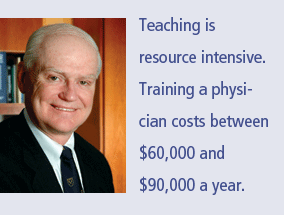












|
 |
| |
Dreaming big |
|
| |
 any
of us have had a favorite automobile. It’s got a few dings,
but the paint job is holding. With regular oil changes and tuneups,
it’s running fine. Still, there are 100,000 miles any
of us have had a favorite automobile. It’s got a few dings,
but the paint job is holding. With regular oil changes and tuneups,
it’s running fine. Still, there are 100,000 miles on the odometer, and soon we’ll have to part with it.
on the odometer, and soon we’ll have to part with it.
The curriculum at Emory University
School of Medicine has something in common with that beloved car.
It has served us well, preparing our students to ace the national
boards and be offered plum residencies throughout the country. It
and others like it have been the blueprint for training the most
preeminent physicians and scientists of the late 20th century. However,
we’ve gotten the maximum mileage out of the current curriculum.
To educate physicians through the first half of the 21st century,
we need a new vehicle for teaching our medical students, one that
is robust, compelling, and flexible.
We aren’t alone in undertaking
these revisions. Between 15 and 20 medical schools in our country
are examining how and what to teach medical students to prepare
them for the demands of modern medicine. At Emory, we have a chance
to be a leader in this effort, and I predict that our revolutionary
curriculum will be a model for the nation.
Our curriculum strategic planning
committee, advised by Jack Shulman and co-chaired by Stephen Warren
and Carlos del Rio, is composed of members from throughout the basic
sciences and clinical faculty, medical students and residents, medical
alumni, and colleagues from the schools of Nursing and Public Health
and Emory College. The initial report is due in August, but already
the committee is working to create a curriculum that reflects student-centered
learning.
This curriculum also will emphasize
flexibility. Our students come to us with intense curiosity and
creativity, and we need to nurture those characteristics rather
than sublimate them in a cookie-cutter approach to making a doctor.
But to fully implement this new curriculum,
we need a new facility. Our new medical education building will
be the first home on campus for Emory’s medical school. An
entirely wireless facility, it will feature advanced technology
classrooms and a variety of teaching and study spaces.
Teaching is a resource-intensive task.
Currently, training a physician costs between $60,000 and $90,000
a year, and the School of Medicine pays for one-third to one-half
of that tab. Still, we are undeterred. In fact, as you’ll
see in this issue of Emory Medicine, we are redoubling our efforts
for teaching medical students. Training the next generation of physicians
is not only our highest priority but also our moral imperative.
We want the finest graduates in the world because, if we aim lower,
we have not fulfilled our pact with society. These are the people
who will be taking care of you and your children. They are the ones
in the driver’s seat in the future. |
|
| |
 |
|
|
|
|